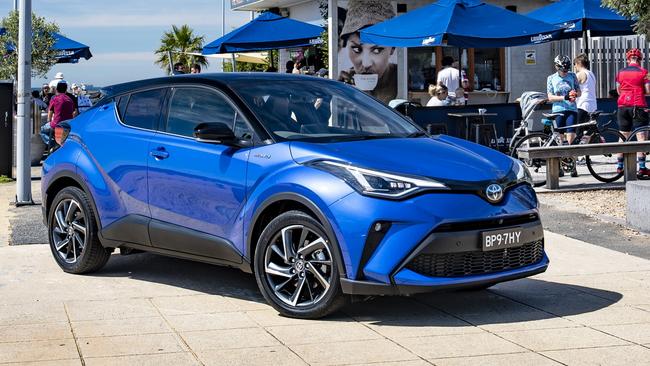Toyota C-HR Hybrid review: A fuel-sipper with panache
There are two hot trends in new cars that buyers can’t get enough of, and the latest addition from Toyota combines both. But there is a catch.

New cars
Don't miss out on the headlines from New cars. Followed categories will be added to My News.
Hybrid sales skyrocketed in 2019, and Toyota is betting that trend will continue in 2019 with the release of its newest petrol-electric model.
But if you are keen on adding the Toyota C-HR Hybrid SUV to your new car shopping list there are some things you’ll need to know including the sky-high price.

1. It’s a Toyota Hybrid with panache
If you’d like to buy a hybrid but the Prius looks too nerdy and the Camry is too common, then the C-HR could be the vehicle for you. It’s easily the most adventurous exterior design in the Toyota range, offering up sharp creases, bright colours and a coupe-like profile that favours style over practicality. The modern approach continues in the cabin, where there’s a mix of diamond patterns on the doors, soft-touch surfaces and brushed metal accents on the dash and partial leather on the seats. The large centre screen sits high on the dash for better visibility and will mirror your smartphone menus.

2. The Prius is still the greenest choice
The C-HR isn’t as fuel efficient as the Prius, but that’s splitting hairs as it still sips a miserly 4.3L/100km. Around town, you can expect it to use half the fuel of a small hatchback, particularly when the traffic gets heavy. While the rest of the C-HR line-up uses a small capacity turbo four-cylinder requiring premium unleaded, the hybrid employs the same 1.8-litre engine as the Prius. The combined output of the engine and hybrid motor is a modest 90kW, but it’s reasonably spritely off the mark.
3. The hybrid isn’t the cheapest option
Toyota expects to sell roughly 40,000 hybrids next year and the key to that success has been to make the technology affordable and accessible. It’s taking a different tack with the C-HR, though. The get-in price for a C-HR is $29,540 but if you want petrol-electric power you have to spend almost $7000 more, as the hybrid’s only available only in the top-of-the-line Koba model. Aside from the hybrid set-up, which adds $2500, you get leather-accented seats, keyless entry and push-button start, bigger 18-inch wheels, LED lights and tech that moisturises the cabin air.

4. The front seats are the place to be
Designers have made sacrifices to produce the youthful, funky looks of the C-HR. While front passengers are well catered for, those in the rear can feel a little claustrophobic, as the leg and headroom aren’t great and there are no rear air vents. The narrow, high-set rear windows create a sleek profile but little ones may find it difficult to peer out. The boot is smallish as well, so those with children would be advised to take a good look at the RAV4.
5. The driving experience is a highlight
Although the engine is modestly powered, the C-HR is surprisingly fun to drive along a twisting country road. Unlike other SUVs, it sits flat through corners and reacts quickly to changes of direction, with minimal leaning and pitching. The steering is light for manoeuvring around town but loads up nicely on the open road. It also soaks up bumps and corrugations reasonably well, although the larger diameter, lower-profile tyres on the Koba don’t absorb road imperfections as well as the more cushioning rubber on cheaper models.
Originally published as Toyota C-HR Hybrid review: A fuel-sipper with panache
